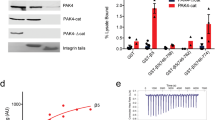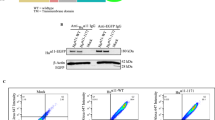Abstract
The critical dependence of receptor-triggered signals on integrin-mediated cell–substrate interactions represents a fundamental biological paradigm in health and disease. However, the molecular connections of these permissive inputs, which operate through integrin–matrix interactions, has remained largely obscure. Here we show that the serine-threonine kinase protein kinase C ε (PKCε) functions as a signal integrator between cytokine and integrin signalling pathways. Integrins are shown to control PKCε phosphorylation acutely by determining complex formation with protein phosphatase 2A (PP2A) and the upstream kinase PDK1 (phosphoinositide-dependent kinase 1). The PP2A-induced loss of PKCε function results in attenuated interferon γ (INF-γ)-induced phosphorylation of STAT1 (signal transducer and activator of transcription 1) downstream of Janus kinase 1/2 (JAK1/2). PKCε function and the IFN-γ response can be recovered by inhibition of PP2A if PDK1 is associated with PKCε in this complex. More directly, a PP2A-resistant mutant of PKCε is sufficient for restoration of the IFN-γ response in suspension culture. Thus, PKCε functions as a central point of integration through which integrin engagement exerts a permissive input on IFN-γ signalling.
This is a preview of subscription content, access via your institution
Access options
Subscribe to this journal
Receive 12 print issues and online access
$209.00 per year
only $17.42 per issue
Buy this article
- Purchase on Springer Link
- Instant access to full article PDF
Prices may be subject to local taxes which are calculated during checkout





Similar content being viewed by others
References
Hynes, R.O. Integrins: versatility, modulation, and signaling in cell adhesion. Cell 69, 11–25 (1992).
Koyama, H., Raines, E.W., Bornfeldt, K.E., Roberts, J.M. & Ross, R. Fibrillar collagen inhibits arterial smooth muscle proliferation through regulation of Cdk2 inhibitors. Cell 87, 1069–1078 (1996).
Fringer, J. & Grinnell, F. Fibroblast quiescence in floating or released collagen matrices: contribution of the ERK signaling pathway and actin cytoskeletal organization. J. Biol. Chem. 276, 31047–31052 (2001).
Ivaska, J., Nissinen, L., Immonen, N., Eriksson, J.E., Kähäri, V.M. & Heino, J. Integrin α2β1 promotes activation of protein phosphatase 2A and dephosphorylation of Akt and glycogen synthase kinase 3β. Mol. Cell. Biol. 22, 1352–1359 (2002).
Schneller, M., Vuori, K. & Ruoslahti, E. αVβ3 integrin associates with activated insulin and PDGFβ receptors and potentiates the biological activity of PDGF. EMBO J. 16, 5600–5607 (1997).
Miyamoto, S., Teramoto, H., Gutkind, J.S. & Yamada, K.M. Integrins can collaborate with growth factors for phosphorylation of receptor tyrosine kinases and MAP kinase activation: roles of integrin aggregation and occupancy of receptors. J. Cell Biol. 135, 1633–1642 (1996).
Howe, A., Aplin, A.E., Alahari, S.K. & Juliano, R.L. Integrin signaling and cell growth control. Curr. Opin. Cell. Biol. 10, 220–231 (1998).
Parekh, D.B., Ziegler, W. & Parker, P.J. Multiple pathways control protein kinase C phosphorylation. EMBO J. 19, 496–503 (2000).
Parekh, D.B. et al. β1-integrin and PTEN control the phosphorylation of protein kinase C. Biochem. J. 352, 425–33 (2000).
England, K., Watson, J., Beale, G., Warner, M., Cross, J. & Rumsby, M. Signaling pathways regulating the dephosphorylation of Ser729 in the hydrophobic domain of protein kinase Cε upon cell passage. J. Biol. Chem. 276, 10437–10442 (2001).
Castrillo, A. et al. Protein kinase Cε is required for macrophage activation and defense against bacterial infection. J. Exp. Med. 194, 1231–1242 (2002).
Saito, Y., Hojo, Y., Tanimoto, T., Abe, J. & Berk, B.C. Protein Kinase Cα and Protein Kinase Cε are required for Grb2-associated Binder-1 tyrosine phosphorylation in response to platelet-derived growth factor. J. Biol. Chem. 277, 23216–23222 (2002).
Balendran, A. et al. PDK1 acquires PDK2 activity in the presence of a synthetic peptide derived from the carboxyl terminus of PRK2. Curr. Biol. 9, 393–404 (1999).
Balendran, A. et al. A 3-phosphoinositide-dependent protein kinase-1 (PDK1) docking site is required for the phosphorylation of PKCζ and PKC-related kinase 2 by PDK1. J. Biol. Chem. 275, 20806–20813 (2000).
Hodgkinson, C.P. & Sale, G.J. Regulation of both PDK1 and the phosphorylation of PKCζ and δ by a C-terminal PRK2 fragment. Biochemistry 41, 561–569 (2002).
Westphal, R.S., Coffee, R.L. Jr, Marotta, A., Pelech, S.L. & Wadzinski, B.E. Identification of kinase-phosphatase signaling modules composed of p70 S6 kinase-protein phosphatase 2A (PP2A) and p21-activated kinase-PP2A. J. Biol. Chem. 274, 687–692 (1999).
Srivastava, J., Goris, J., Dilworth, S.M. & Parker, P.J. Dephosphorylation of PKCδ by protein phosphatase 2Ac and its inhibition by nucleotides. FEBS Lett. 516, 265–269 (2002).
Heriche, J.K. et al. Regulation of protein phosphatase 2A by direct interaction with casein kinase 2α. Science 276, 952–955 (1997).
Westphal, R.S., Anderson, K.A., Means, A.R. & Wadzinski, B.E. A signaling complex of Ca2+-calmodulin-dependent protein kinase IV and protein phosphatase 2A. Science 280, 1258–1261 (1998).
Parekh, D., Ziegler, W., Yonezawa, K., Hara, K. & Parker, P.J. Mammalian TOR controls one of two kinase pathways acting upon nPKCδ and nPKCε. J. Biol. Chem. 274, 34758–34764 (1999).
Ivaska, J., Whelan, R.D.H., Watson, R. & Parker, P.J. PKCε controls the traffic of β1 integrins in motile cells. EMBO J. 21, 3608–3619 (2002).
Le Good, J.A. et al. Protein kinase C isotypes controlled by phosphoinositide 3-kinase through the protein kinase PDK1. Science 281, 2042–2045 (1998).
Köster,M. & Hauser,H. Dynamic redistribution of STAT1 protein in IFN- signaling visualized by GFP fusion proteins. Eur. J. Biochem. 260, 137–144 (1999).
Costa-Pereira, A.P. et al. Mutational switch of an IL-6 response to an interferon-gamma-like response. Proc. Natl Acad. Sci. USA 99, 8043–8047 (2002).
Saharinen, P. & Silvennoinen, O. The pseudokinase domain is required for suppression of basal activity of Jak2 and Jak3 tyrosine kinases and for cytokine-inducible activation of signal transduction. J. Biol. Chem. 277, 47954–47963 (2002).
Acknowledgements
We wish to thank F. Watt and G. Schiavo for their valuable comments and J. Goris (Catholic University, Leuven, Belgium) for phosphorylated inhibitor-1. We also thank A. Costa-Pereira for technical advice. J.I. is an EMBO long-term fellow and is supported by grants from the Academy of Finland, Emil Aaltonen Foundation, Finnish Cancer Association, Finnish Cultural Foundation, Irja Karvonen Cancer Foundation, Leiras Research Foundation, HS100v foundation and Maud Kuistila's Foundation. This work was supported in part by the European Community, grant QLK3-CT-2000-01038.
Author information
Authors and Affiliations
Corresponding author
Ethics declarations
Competing interests
The authors declare no competing financial interests.
Supplementary information
Supplementary Figure
Figure S1 Phosphatases that act on PKCe are activated upon cell detachment and in response to fibrillar collagen. (PDF 134 kb)
Rights and permissions
About this article
Cite this article
Ivaska, J., Bosca, L. & Parker, P. PKCε is a permissive link in integrin-dependent IFN-γ signalling that facilitates JAK phosphorylation of STAT1. Nat Cell Biol 5, 363–369 (2003). https://doi.org/10.1038/ncb957
Received:
Revised:
Accepted:
Published:
Issue Date:
DOI: https://doi.org/10.1038/ncb957
This article is cited by
-
Equivocal, explicit and emergent actions of PKC isoforms in cancer
Nature Reviews Cancer (2021)
-
Interferon-inducible cytoplasmic lncLrrc55-AS promotes antiviral innate responses by strengthening IRF3 phosphorylation
Cell Research (2019)
-
Could interferon-gamma be a therapeutic target for treating heart failure?
Heart Failure Reviews (2014)
-
PKC alpha regulates Sendai virus-mediated interferon induction through HDAC6 and β-catenin
The EMBO Journal (2011)
-
Interplay between cell adhesion and growth factor receptors: from the plasma membrane to the endosomes
Cell and Tissue Research (2010)



